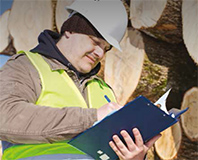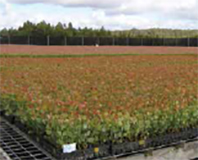Plantation monitoring for the early detection of pests and diseases
Monitoring your plantation provides the best protection against new pests and diseases. Any new pests or unusual symptoms should be reported.
Plantation forestry | Plantation forestry pests | Forestry biosecurity practices | Hypothetical incursion | Plantation forestry quality assurance
The following information details biosecurity practices for aspects of plantation operations. Assess the strengths and weaknesses of your current arrangements using the biosecurity checklist and make a biosecurity plan to address any gaps that might leave you at risk.

Monitoring your plantation provides the best protection against new pests and diseases. Any new pests or unusual symptoms should be reported.
Training should be provided to staff to increase their level of biosecurity awareness, including the ability to recognise high priority exotic pests and diseases and who to report possible sightings to.
Monitoring the health of your plantation is a fundamental part of plantation management and gives the best chance of spotting a new pest or disease soon after it arrives. You, your workers, contractors or consultants should be looking over your plantation on a regular basis.
Pay particular attention to high risk areas where pests are most likely to enter and establish on your property such as along public roads and around depots.
Surveillance involves looking for pests and diseases, any symptoms, or plant health issues in your plantation, and recording their presence and population levels or their absence. If your company employs forest health professionals these records will already be maintained; otherwise you are responsible for maintaining your own records. (Pest surveillance record)
In addition to assisting with plantation management, pest and disease surveillance is important for maintaining the biosecurity status of the Australian plantation forest industry.

Export destinations often require ‘evidence of absence’ data for particular exotic and established pests and diseases. Your regular pest and disease surveillance activities can assist in providing evidence of absence and potentially help to keep trade markets open.
Pest and disease surveillance increases the chances that a new pest or disease is detected early and can be contained and eradicated. A new pest or disease in your plantation might also be new to the region or even the country.
Along with plantation monitoring and pest and disease surveillance, prompt reporting is vital to minimise the long-term impact of exotic pests or diseases in your plantation and the forest industry as a whole.
While Australia has one of the strictest border control systems in the world, there is always the chance that an exotic pest or disease will make it into the country. The number of passengers and imported goods is increasing, and a serious exotic pest or disease of the forest industry might only be a day’s flight away.

Always source planting material from reputable nurseries. Inspect material on arrival to reduce the risk of pests and diseases from entering and establishing in your plantation.
Infected, infested or contaminated propagation material is a source of pests and diseases, allowing them to enter your plantation. It can be difficult to accurately assess the quality of propagation material just by sight as it can appear clean and healthy at the time of purchase. Pathogens may require certain environmental conditions or extended periods of time before they show obvious symptoms.
Plantation managers should ensure that they use reputable nurseries that have systems in place to ensure the supply of high quality, pest and disease free material. Material should also be checked thoroughly on arrival for pests and diseases.
Supplying nurseries should ensure propagation material is sourced from reputable suppliers who maintain records of where material was sourced and grown.
Plantation managers should maintain a register of their propagation material to allow products to be fully traced. Information recorded should include the source of the material and contact details, variety/provenance, number of plants obtained, areas on the property where the material was planted and the planting date.
Never use poor quality or pest/disease-affected planting material, as it has the potential to infect your entire plantation.
People, vehicles and machinery can carry pests and diseases onto and around your plantation.
Pests and diseases can be spread in soil and on plant material that adheres to vehicles, equipment, footwear and clothing. Anyone visiting your plantation or property is a potential biosecurity threat.
Not all plantation owners will be able to implement all of these suggestions. However, where feasible these recommendations will assist in managing biosecurity risks.
Well-designed signs demonstrate your commitment to plantation biosecurity. They also serve to alert people to the potential impact of their visit, and remind them that they share responsibility for maintaining biosecurity.
Signs should be placed at the main external entrances, in visitor parking areas and at any wash-down facilities. (Plantation biosecurity sign)
If possible, direct all visitors (such as utility providers and contractors) to a designated area and ask them to notify you of their presence. Ask that people stay to paths and designated roadways as much as possible when moving around the plantation.
Controlling and limiting access to production areas will assist in minimising biosecurity risks.
Some people pose an increased biosecurity risk to your plantation and need to be managed. High risk people include anyone who travels from plantation to-plantation or from one region to another. Notable examples are contractors, workers, earthmoving companies, fire fighters, utility providers (such as power, water, gas and communications employees), research personnel, consultants and mining operators, any of whom might enter properties in their day-to-day operations.
Make sure that staff, contractors, consultants and anyone entering your plantation knows about your biosecurity requirements. These messages could be included in visitor induction sessions, handout material or operating procedures (where applicable).
Make sure workers know about any biosecurity risks in the region or specific issues in the plantation. They should also be familiar with common pests or diseases in the plantation and know how to report anything unusual.
It is good practice to maintain a visitor register to document who has been on your property, where they have come from and where they are going in the plantation and after they leave. Visitor/contractor records are one of the most useful tools in the event of a serious pest or disease incursion. These records allow investigators to trace the origin and spread of any incursion.

Any machinery coming onto your property poses a risk of spreading pests and diseases between plantations.
It is important to keep all equipment clean and ensure that any machinery brought into the plantation does not pose a risk. Follow appropriate hygiene practices. As an example, if the vehicle has been operating in a high risk area, adopt more stringent measures, such as vehicle wash-down.
Each state has legislation and/or codes of practice in place governing the movement of machinery, equipment and other potential sources of pest or disease contamination.
The Australian Interstate Quarantine website provides information about domestic quarantine.
The same site contains information about the Subcommittee on Domestic Quarantine and Market Access and lists the Interstate Certificates of Assurance that relate to moving commercial consignments of products between states.
While it may seem like a lot of effort, inspecting and cleaning vehicles and machinery is more time and cost effective than managing a new pest or disease.